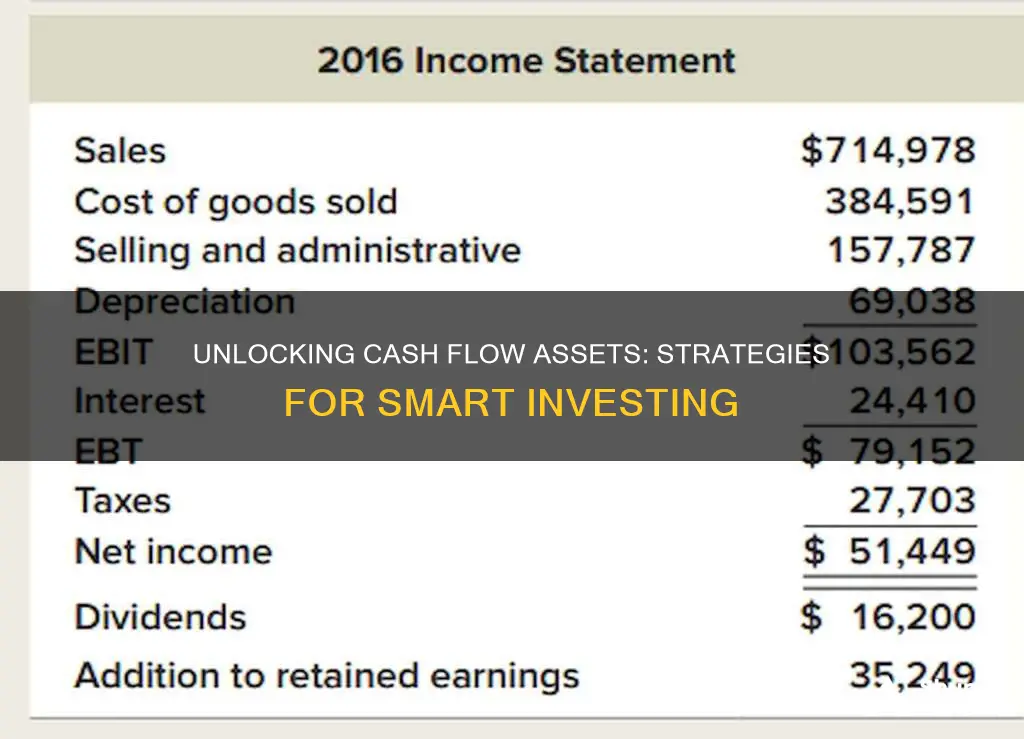
Investing in cash flow assets is a great way to build wealth over time and secure financial freedom. Cash flow assets are investments that generate regular income without requiring active management from the investor. The most common types of cash flow assets include dividend-paying stocks, bonds, real estate, and other assets that provide recurring cash payments.
- Rental real estate: Investors can profit from rental income and potential gains from property appreciation.
- Dividend-paying stocks: Companies that regularly pay out dividends provide a steady income stream.
- Real estate investment trusts (REITs): These are companies that invest in diverse real estate assets, offering shares that can be traded on stock markets.
- Bonds and bond index funds: Bonds are loans to governments or companies that provide fixed-interest payments.
- Short-term vacation rentals: These can generate higher rental income but also come with larger operating expenses.
- Real estate crowdfunding: Investors pool their money to purchase shares in large residential or commercial projects.
- Private equity investing: Investing in private companies, particularly those in early development, can offer attractive returns but carries higher risk.
- Peer-to-peer lending: Investors lend money to borrowers who are often denied by traditional financial institutions, offering moderate returns with some risk.
- Savings accounts, certificates of deposit, and money market accounts: These are low-risk options that offer relatively lower returns but provide high liquidity and minimal capital requirements.
- Annuities: Contracts with insurance companies that provide regular payments over a set period or for life, often favoured by retirees.
- Cryptocurrency DeFi: A newer way to generate income by investing in cryptocurrencies and earning yields through decentralised exchanges, but it comes with higher risk and volatility.
| Characteristics | Values |
|---|---|
| Type of asset | Cash-flowing passive income asset |
| Income type | Regular, usually monthly, quarterly, or yearly |
| Income source | Rent, dividends, interest, royalties, or profits from sales |
| Nature of income | Passive |
| Risk | High; dependent on market conditions and other factors |
| Initial investment | Significant |
| Effort | Minimal |
| Examples | Real estate rental property, dividend-paying stocks, high-yield savings accounts, REITs, annuities, monetized digital assets, royalties from creative works |
What You'll Learn

Dividend-Paying Stocks
When a company declares a dividend, it credits a liability account called a dividend payable. On the payment date, the company reverses the dividend payable with a debit entry and credits its cash account for the respective outflow. Dividends are often paid out on a regular basis, such as monthly, quarterly, or annually, but they can also be one-time payouts.
It's important to note that dividend-paying companies are generally more established, with stable cash flows. This means they have fewer opportunities to invest in growth initiatives, so they choose to return cash to shareholders instead. No two companies are the same, so the percentage rate for dividends (dividend yield) will vary by company. Quality companies with consistent earnings and a history of paying dividends regularly are known as "blue-chip stocks" and tend to carry less risk than growth companies.
- 3M
- AbbVie Inc. (a healthcare company)
- Caterpillar Inc.
- The Coca-Cola Company
- PepsiCo Inc.
- Realty Income Corp.
To invest in dividend-paying stocks, you can consider using investment apps or platforms such as Robinhood, which offer commission-free trades and other features to help you get started.
Understanding Cash Flows from Investing Activities
You may want to see also

High-Yield Savings Accounts
With a high-yield savings account, your balance can grow faster over time without any additional effort on your part. For example, after one year, a savings account balance of $10,000 would earn $10 in an account with a 0.10% APY. If this money had been placed in a high-yield savings account offering 3.00% APY, it would have earned 30 times more, or a total of $300.
When choosing a high-yield savings account, it is important to consider not only the APY but also any monthly fees, minimum balance requirements, and other features such as mobile app ratings and customer service availability. Some high-yield savings accounts may also come with a checking account, which can be beneficial for those who want their spending and savings reserves under the same roof.
- Barclays Tiered Savings Account: Offers an APY of 4.50% for balances of $0 to <$250,000 and 4.80% for balances of $250,000 or more. There is no minimum balance requirement to earn APY, and there are no monthly fees.
- SoFi Checking and Savings: A combination of checking and savings account that earns an APY of 4.20% on the savings portion. To earn this rate, you must set up direct deposit in any amount or make manual deposits of at least $5,000 every 30 days. Without either of these, you will earn a lower APY of 1.20% on your savings balance. SoFi also offers a checking account that earns 0.50% APY. There is no minimum deposit requirement and no monthly maintenance fee.
- CIT Bank Platinum Savings: Pays an APY of 4.55% on balances of $5,000 or more. If your balance dips below $5,000, it earns a lower APY of 0.25%. There is a minimum opening deposit of $100 and no monthly fee.
- Openbank High Yield Savings: Offers an APY that is much higher than the national average, currently at 5.00%. There is a minimum balance requirement of $500 to earn APY, and the account is not available to residents of certain states.
- UFB Portfolio Savings: Offers an APY of up to 4.31% on all balance tiers with no activity or minimum requirements. There is no minimum balance or deposit requirement, and interest is compounded daily. There is a limit of six free withdrawals per month, with each additional withdrawal incurring a $10 excess withdrawal fee.
- American Express High Yield Savings Account: Offers a competitive APY of 4.00% with no minimum balance requirement to open the account or earn interest. There is a $1 minimum to start earning interest, and there are no monthly maintenance fees.
Invest to Conceal Cash: Strategies for Discreet Money Management
You may want to see also

Real Estate Investment Trusts
REITs are traded on major stock exchanges, and they offer a number of benefits to investors. They are required to distribute at least 90% of their net income to shareholders in the form of dividends, and they have to meet a number of requirements to qualify as REITs.
- How they work: Most REITs operate by leasing space and collecting rent on their properties. They then pay out the income generated to shareholders as dividends.
- Types of REITs: There are three main types of REITs: Equity REITs, which own and operate real estate properties; Mortgage REITs, which own debt securities backed by real estate; and Hybrid REITs, which combine both equity and mortgage REITs.
- Benefits of investing in REITs: REITs offer steady dividends, high returns, liquidity, and lower volatility compared to traditional stocks. They are also an excellent portfolio diversifier due to their low correlation with other assets.
- Risks of investing in REITs: REITs tend to have a lot of debt, and they may struggle to raise cash by issuing new stock shares and bonds during financial crises or recessions. They also pass on a tax burden to investors, who have to pay taxes on any dividends received unless they are held in a tax-advantaged account. Additionally, non-traded and private REITs can be expensive, illiquid, and hard to value and trade.
- How to invest: You can buy shares in a REIT listed on major stock exchanges, just like any other public stock. You can also purchase shares in a REIT mutual fund or exchange-traded fund (ETF) for instant diversification.
- Examples of REITs: Some top-performing publicly listed REITs include SL Green Realty Corp., Vornado Realty Trust, and Piedmont Office Realty Trust, Inc.
Overall, REITs are a great option for those looking to invest in real estate without the hassle of property management and for those seeking steady dividend income with lower volatility.
Investing: Negative Cash Flow's Impact and Insights
You may want to see also

Money Market Funds
There are four different types of money market fund strategies, each of which invests in different kinds of securities in addition to holding cash and cash equivalents:
- Government money market funds invest at least 99.5% of assets in cash, government securities, or repurchase agreements that are collateralized by government securities.
- Short-term credit (Prime) money market funds can invest in government securities and securities issued by banks, corporations, and other non-government entities.
- Municipal money market funds buy municipal bonds and other debt securities, which are typically exempt from federal and sometimes state income tax.
- Standard money market funds are designed with a minimum investment horizon of three months and offer the opportunity for higher yields by holding less liquidity, longer duration, and slightly lower credit quality.
Cash App Investment Options: Where to Put Your Money
You may want to see also

Annuities
There are two main types of annuities: immediate and deferred. Immediate annuities start paying out income immediately (within 12 months), while deferred annuities delay payments until a future date (after 12 months). This flexibility allows individuals to choose the annuity that aligns with their retirement goals and timeline.
Understanding Cash Flow: Investing Activities Explained
You may want to see also
Frequently asked questions
Cash flow assets are investments that generate regular income for the owner without requiring active participation in the operation or management of the investment. The income can be in the form of rent, dividends, interest, royalties, or profits from sales.
Examples of cash flow assets include real estate, dividend-paying stocks, high-yield savings accounts, bonds, and annuities.
Investing in cash flow assets can provide a stable and consistent income stream with minimal ongoing effort. It can also help diversify your investment portfolio and reduce the impact of market volatility on your investments.







